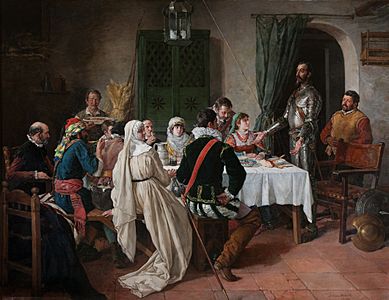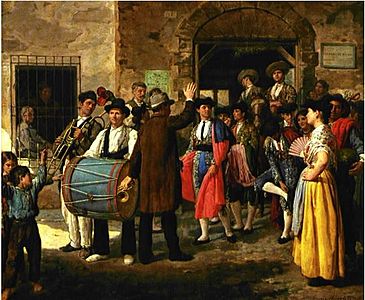Manuel García Hispaleto facts for kids
Manuel García Hispaleto, whose original name was Manuel García y Martínez, was a talented Spanish painter. He was born in Seville on November 22, 1836, and passed away in Madrid on December 26, 1898. Manuel was especially known for painting portraits of people and costumbrista scenes, which showed everyday life and customs. His brother, Rafael García Hispaleto, was also a painter. Manuel later adopted the name "Hispaleto" to honor his brother.
Contents
Manuel's Early Life and Art Studies
Manuel's father had a business that sold imported goods, but it wasn't very successful. When Manuel was just 11 years old, in 1847, he started taking art classes. He studied at the Real Academia de Bellas Artes de Santa Isabel de Hungría in Seville. His older brother, Rafael, also went to this art school. In 1853, Rafael started using the nickname "Hispaleto." This name was a nod to "Hispalis," which was the old Roman name for Seville. After Rafael sadly passed away at a young age (only 22), Manuel decided to use the name "Hispaleto" himself to remember his brother.
In 1854, Manuel moved to Madrid to continue his art education. He attended the "Escuela de Santa Catalina," which was a school connected to the Real Academia de Bellas Artes de San Fernando.
Manuel's Art Exhibitions and Awards
Starting in 1860, Manuel regularly showed his paintings at the National Exhibition of Fine Arts in Spain. He continued to exhibit his work there until 1895. Some of his paintings even won medals! In 1871, he received a special honor called the Order of Charles III.
In 1872, Manuel went back to Seville. He wanted to find new ideas for his costumbrista paintings by looking at the daily life in Andalusia, a region in southern Spain. Two years later, he returned to Madrid for an art show at the Real Fábrica de Platería Martínez. There, he met Esperanza Romero Cabrero. She was the daughter of the owner of the Platería, María del Rosario Cabrero, and her husband, the poet Gregorio Romero Larrañaga.
Manuel stayed in Madrid, and five years later, he and Esperanza got married at the Basílica pontificia de San Miguel. They had three children together, though one of them sadly died when they were very young.
Manuel's Teaching and Other Work
Manuel was one of the artists who helped start the Sociedad de Acuarelistas, which was a group for watercolor painters. He also attended their yearly art shows. For many years, he worked as a professor at the Escuela de Artes y Oficios de Madrid, teaching art to students. Besides painting, Manuel also helped restore old artworks at the famous Museo del Prado. He even created some lithographs, which are a type of print.
Selected Paintings
-
Alfonso XIII
as a Cadet -
Don Quixote's Speech on Arms and Letters
See also
 In Spanish: Manuel García Hispaleto para niños
In Spanish: Manuel García Hispaleto para niños





